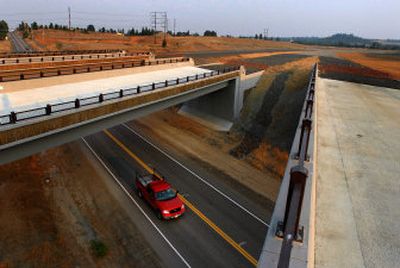Needs lap funds for Interstate 90, corridor

Interstate 90 offered quick trips when it was built 50 years ago in Spokane and Coeur d’Alene.
Traffic was minimal and the roadway was smooth and new.
But now I-90 is experiencing growing pains.
During peak times, congestion reaches critical levels between Spokane Valley’s Sullivan Road exit and Coeur d’Alene, and ruts and pits pock I-90’s surface in much of Spokane and Kootenai County’s urban areas.
And without additional funding, Washington State Department of Transportation work on its latest Eastern Washington freeway, the North Spokane Corridor, will reach a standstill by 2011, still 4 ½ miles from I-90.
Growing traffic
Traffic growth between the Havana Street and Sprague Avenue interchanges has been remarkable over the years.
From 1990 to 2005, traffic counts on that stretch of I-90 grew from 72,775 to 105,000 vehicles per day – a jump of about 43 percent. And while the counts have gone up by only 1,000 vehicles a day since 2000, that may indicate only that drivers are finding other routes to avoid freeway congestion.
“We’re dropping down to service level D and E. That means it’s becoming more congested,” said Jerry Lenzi, eastern region director for the Washington State Department of Transportation.
“We like to keep our roads at C,” Lenzi added.
Level of service grades are a lot like grades on school report cards. To earn an A, a highway would have to be free flowing. Freeways usually only reach an A rating in rural areas or in the middle of the night, not during the day in urban areas like Spokane. C means traffic maintains a stable flow. Highways graded D are approaching unstable flow and E is for unstable flow where traffic is frequently prevented from reaching the speed limit. An F would be given to a highway frequently in gridlock.
I-90 doesn’t get an F anywhere in Spokane or North Idaho.
In Post Falls, I-90 traffic has increased more than 71 percent in the last 15 years, from 28,475 vehicles per day in 1990 to 48,877 per day last year.
“We’ll have days where it’s well over 60,000,” said Tim Turrell, an Idaho Transportation Department traffic engineer.
That’s not good for the four-lane freeway.
Larry Wolf said he remembers when a drive on I-90 meant a smooth trip with little traffic, but that began to change in the early 1990s as more people moved to Kootenai County.
Wolf, a retired assistant district engineer for ITD, said growth is catching up to the highway’s capacity.
“There’s only so many cars you can move down a given highway in an hour’s time,” said Wolf. “Interstate 90 is probably pushing the limit in the Post Falls area, to the state line and into Washington.”
No money
Money was available for almost four decades to build I-90 locally, but current efforts to expand it are largely meeting gridlock.
Neither Idaho nor Washington has money allocated to add I-90 lanes in Spokane or Kootenai counties.
“We have nothing programmed,” said ITD’s Turrell.
Wolf said that in addition to extra capacity, I-90 could use another interchange in Post Falls, but there are no plans for one.
Though the Washington State Department of Transportation is planning to widen I-90 between Sullivan and the Idaho state line, there is no money now to actually build the lanes.
Part of the problem is Eastern Washington’s place in the grander scheme of Washington transportation issues, said Dale Stedman of the Spokane Area Good Roads Association. He also is a member of the Washington State Transportation Commission.
“Demand here isn’t as high as in other parts of the state,” said Stedman.
Congestion is much worse in the Puget Sound area. And several safety projects there, like replacing the Alaskan Way Viaduct and the Highway 520 bridge, have costs in the billions of dollars.
Then there is work on Interstate 5.
“I-5 is by far the most heavily traveled roadway in Washington, Oregon and California,” said Stedman.
Broken corridor
Spokane drivers will have a highway from Market Street and Francis Avenue to Wandermere by 2011 – the northern portion of the North Spokane Corridor, a freeway that has been sought in one form or another for 60 years.
The first 4.4-mile, two-lane segment is expected to open between Francis and Farwell Road in late 2008. Then a second, 1.5-mile, four-lane section will open from Highway 2 to Wandermere in 2011.
But no one knows when the corridor will be extended south to meet I-90 because the state doesn’t have money set aside to build it. Though money was included in recent gas tax allocations to do more design work and buy some right of way, there were no funds set aside for construction and concrete.
The estimated cost for the entire project is $2.1 billion in 2006 dollars, and the section between the Spokane River and I-90 will be the most expensive to build. And it’s getting more expensive all the time, as real estate and construction costs climb.
“We’ll build it just as soon as the money comes along, but I can’t tell you when that will be,” said Lenzi.
For Stedman, even starting the North Spokane Corridor is a major accomplishment. “The biggest job in a new highway is the first spade, the first shovel of dirt moved,” he said.
But Stedman isn’t satisfied with leaving the project as it is now. He and other local transportation advocates are working to build a coalition of local leaders to make the North Spokane Corridor a top state and national transportation priority.
The corridor is part of a major north-south transportation route linking Canada, the United States and Mexico. It’s ranked 19th of 43 on the Congressional High Priority Corridor list for the national highway system.
Said Stedman: “The idea, of course, is that once started, you should not stop until you’ve completed the project.”